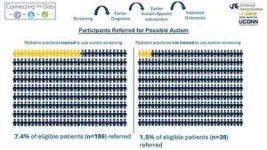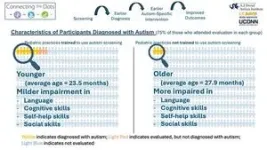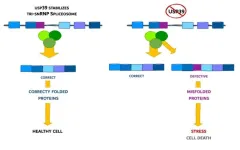(Press-News.org) New research from Drexel University’s A.J. Drexel Autism Institute found that the use of standardized autism screening during pediatric well-child visits identifies more children with high autism likelihood at a younger age, including those presenting with more subtle symptoms. This is the first large-scale, randomized trial to test the impact of standardized autism screening on early detection of autism in pediatric primary care.
Recently published in the Journal of the American Academy of Child & Adolescent Psychology, the multi-site study tested whether using standardized autism toddler screening – the Modified Checklist for Autism in Toddlers, Revised, with Follow-Up (M-CHAT-R/F) – during pediatric well-child visits would result in a higher number of children receiving an autism diagnosis at a younger age compared to usual care.
Usual care is generally a combination of screening that is not standardized, or low fidelity (meaning that clinicians did not use the screening tool as it was intended) and clinical judgment to determine whether to refer a child for diagnostic evaluation and early intervention.
In the study, 31 pediatric practices across three sites near Philadelphia, Pennsylvania; Storrs, Connecticut; and Sacramento, California were randomly assigned to an experimental condition involving training and supervision in the universal, standardized, high-fidelity use of M-CHAT-R/F, or to usual care.
Pediatric practices in both groups referred toddlers who showed signs of autism during 18-month well-child visits to the research team for a diagnostic evaluation.
“We found that the practices randomly assigned to standardized screening — meaning the screener was administered and scored the same way for every child — identified children with a high likelihood of autism more frequently and more timely compared to practices in the usual care group,” said Giacomo Vivanti, PhD, an associate professor in the Autism Institute and lead author of the study. “This resulted in 186 children referred to a diagnostic evaluation — and their average age was 20.6 months, compared to 39 children with an average age of 23.6 months referred by practices in the usual care group.”
The research team found that most of the children who attended the evaluation in both conditions received a diagnosis of autism. Children referred by practices that used standardized autism screening had a wider range of clinical presentations, including milder manifestations in areas like language and cognition, compared to those referred from usual care practices – indicating that using the screening may counteract the tendency to only refer children with more obvious impairments.
The study results indicate that routine, standardized screening for all children at toddler well visits, coupled with immediate referrals for diagnosis for those showing likelihood of autism during the screening, is superior to relying on non-standardized use of screeners or clinicians’ judgment for identifying children with autism.
“The earlier identification of autism allows for autism-specific early intervention at a younger age, which improves outcomes across the rest of their lives,” said Diana Robins, PhD, the director of the Autism Institute and creator of the M-CHAT-R/F, who was the principal investigator in the study.
The research team envisions that policies and guidelines align to support the use of routine, standardized autism screening for all children at toddler well visits.
“Although the American Academy of Pediatrics has been recommending universal, standardized autism screening at 18- and 24-month well-child visits for nearly 20 years, it is clear that community implementation lags behind best practices,” said Vivanti and Robins.
They added that they hope that these findings will emphasize the need to administer, score, and follow recommended actions of screeners according to their instructions, rather than using screeners in non-standardized ways, or relying on clinical judgment to determine whether or not to refer toddlers for autism evaluations and early intervention, effectively over-riding when a screener indicates that referrals are needed.
Read the full study here: https://www.jaacap.org/article/S0890-8567(24)01933-6/fulltext.
END
Standardized autism screening during pediatric well visits identified more, younger children with high likelihood for autism diagnosis
2024-11-14
ELSE PRESS RELEASES FROM THIS DATE:
Researchers shed light on skin tone bias in breast cancer imaging
2024-11-14
Breast cancer is a major health concern worldwide, and early detection is crucial for effective treatment. Traditional imaging methods, such as mammography, have limitations, especially for women with dense breast tissue. Photoacoustic imaging, which combines light and sound to create detailed images of breast tissue, offers a promising alternative. However, recent research has highlighted a significant challenge: skin tone bias.
A team of researchers from Johns Hopkins University recently investigated how skin tone affects the visibility of breast cancer targets in photoacoustic imaging. As reported in Biophotonics Discovery, the study focused on three image ...
Study finds humidity diminishes daytime cooling gains in urban green spaces
2024-11-14
Urban green spaces provide shade for city dwellers facing rising temperatures brought on by climate change, but how much relief from the heat island effect do they provide when humidity is factored in?
The temperature and humidity effect cancel each other out during daylight hours, but green spaces provide a net reduction in humid heat at night, according to a new study in Nature Cities, co-authored by Yale School of the Environment doctoral student Yichen Yang and Xuhui Lee, Sara Shallenberger Brown Professor of Climate Science.
"When it comes to urban ...
Tennessee RiverLine secures $500,000 Appalachian Regional Commission Grant for river experience planning and design standards
2024-11-14
The Tennessee RiverLine, an initiative of University of Tennessee Extension, has been awarded a $500,000 Area Development grant from the Appalachian Regional Commission (ARC) and Tennessee Department of Economic and Community Development to support the development of comprehensive Planning and Design Standards. These standards will help accelerate the creation of new river experience amenities along the 652-mile stretch of the Tennessee River, benefitting residents and visitors throughout the region.
The 18-month project will be led by a professional ...
AI tool ‘sees’ cancer gene signatures in biopsy images
2024-11-14
To determine the type and severity of a cancer, pathologists typically analyze thin slices of a tumor biopsy under a microscope. But to figure out what genomic changes are driving the tumor’s growth — information that can guide how it is treated — scientists must perform genetic sequencing of the RNA isolated from the tumor, a process that can take weeks and costs thousands of dollars.
Now, Stanford Medicine researchers have developed an artificial intelligence-powered computational program that can predict the activity of thousands of genes within tumor cells based only on standard microscopy images of the biopsy. The tool, described online in Nature Communications Nov. 14, ...
Answer ALS releases world's largest ALS patient-based iPSC and bio data repository
2024-11-14
Answer ALS Releases World's Largest ALS Patient-Based iPSC and Bio Data Repository
Unprecedented resource, created with Cedars-Sinai, to accelerate ALS research and drive development of targeted therapies globally
NEW ORLEANS, [November 14, 2024] — In a landmark continuing collaboration, Answer ALS and Cedars-Sinai have announced the completed availability of the largest amyotrophic lateral sclerosis (ALS) patient-based induced pluripotent stem cell (iPSC) and bio data repository. The repository encompasses biological and clinical data from nearly 1,000 ALS patients, offering an unprecedented resource for global ...
2024 Joseph A. Johnson Award Goes to Johns Hopkins University Assistant Professor Danielle Speller
2024-11-14
WASHINGTON, Nov. 14, 2024 – AIP and the National Society of Black Physicists congratulate Danielle Speller as the winner of the 2024 Joseph A. Johnson Award for Excellence. Jessica Esquivel is also being recognized with an Honorable Mention.
The Johnson Award, now in its fifth year, is given jointly by AIP and NSBP to recognize early-career scientists who demonstrate scientific ingenuity and impactful mentorship and service—the core values of NSBP founder Joseph A. Johnson.
“Dr. Speller not only ...
Slow editing of protein blueprints leads to cell death
2024-11-14
FRANKFURT. Genes contain the essential building instructions for life, guiding cells on which amino acids to assemble in what sequence to produce specific proteins. The human genome codes for about 20,000 such instructions. “Nevertheless, our cells can produce several hundred thousand different proteins,” explains Prof. Ivan Đikić from the Institute of Biochemistry II at Goethe University Frankfurt.
This diversity is enabled by a process known as “splicing.” When a cell requires a protein, it generates a copy of the relevant instructions in the cell nucleus. During splicing, this transcript undergoes modification: a cellular editing complex, the spliceosome, ...
Industrial air pollution triggers ice formation in clouds, reducing cloud cover and boosting snowfall
2024-11-14
Pollution from industrial hotspots can trigger ice formation in supercooled clouds, altering their reflective properties and increasing regional snowfall, according to a new study. The findings shed light on poorly understood impacts of anthropogenic aerosols on climate and could help improve climate modeling and mitigation strategies. The impact of human-generated aerosols (tiny air pollution particles) on climate, particularly in counteracting greenhouse gas-induced warming, remains uncertain. These aerosols, in addition to influencing cloud formation as cloud condensation nuclei (CCN), may also act as ice-nucleating particles (INPs), crucial for ice formation in supercooled ...
Emerging alternatives to reduce animal testing show promise
2024-11-14
In a Policy Forum, Chad Nelson and colleagues highlight the efforts of the U.S. Food and Drug Administration (FDA) in advancing alternative methods to reduce animal testing for regulatory use. Animal studies have been crucial for advancing disease understanding, developing therapies, and assessing the safety and effectiveness of consumer products. However, reducing animal use and developing effective alternatives is an ongoing priority. Although advances in biology, engineering, and artificial intelligence offer new opportunities to improve product safety assessments, these technologies require extensive development to meet regulatory ...
Presenting Evo – a model for decoding and designing genetic sequences
2024-11-14
A new study presents “Evo” – a machine learning model capable of decoding and designing DNA, RNA, and protein sequences, from molecular to genome scale, with unparalleled accuracy. Evo’s ability to predict, generate, and engineer entire genomic sequences could change the way synthetic biology is done. “The ability to predict the effects of mutations across all layers of regulation in the cell and to design DNA sequences to manipulate cell function would have tremendous diagnostic and therapeutic implications for disease,” writes Christina Theodoris ...








